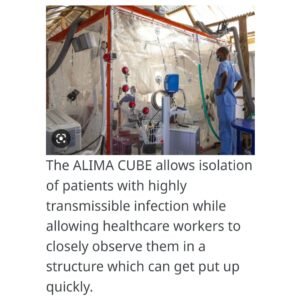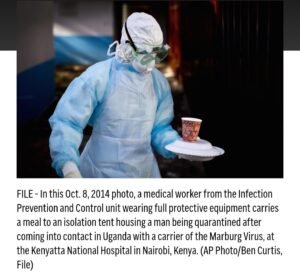
Photo Credit: WHO
Rwanda, October 2, 2024 – The highly contagious Marburg virus has claimed the lives of eight people in Rwanda, just days after the country declared an outbreak of the deadly hemorrhagic fever. The Ministry of Health has confirmed that the outbreak has so far led to 26 confirmed cases of the virus.
Health Minister Sabin Nsanzimana announced the grim update, stating that authorities are working to contain the spread. “Marburg is a rare disease,” Nsanzimana told reporters on Sunday. “We are intensifying contact tracing and testing to help stop the spread.” He also noted that the source of the current outbreak remains undetermined.
What is Marburg Virus?
Marburg virus, which belongs to the same family as the Ebola virus, is an extremely rare but deadly pathogen. It was first identified in 1967 after causing simultaneous outbreaks in laboratories in Marburg, Germany, and Belgrade, Serbia, resulting in the deaths of seven researchers who had been exposed to infected monkeys.
According to the World Health Organization (WHO), Marburg virus is thought to originate in fruit bats. It spreads between humans through direct contact with the bodily fluids of infected individuals, as well as through contaminated surfaces such as bedding, clothing, and medical equipment. Importantly, WHO notes that Marburg virus does not spread through the air, differentiating it from other viral infections like influenza or COVID-19.
Marburg Virus Symptoms
Symptoms of Marburg virus infection can appear anywhere between three days to three weeks after exposure. Early signs include fever, chills, headache, and muscle pain. As the infection progresses, patients may experience a rash, chest pain, sore throat, and gastrointestinal issues such as diarrhea and vomiting. In severe cases, unexplained bleeding or bruising occurs, often accompanied by shock, delirium, and organ failure, the WHO reports.

“In the later stages of the disease, bleeding from various sites such as the gums, nose, and anus can occur,” Nsanzimana added. The virus has a mortality rate of up to 88% in untreated cases, making swift identification and isolation critical to containing outbreaks.
Ongoing Efforts to Contain the Virus
Rwandan health authorities are now racing to prevent further spread of the virus. “We are focusing our efforts on contact tracing to identify those who may have been exposed, as well as increased testing across affected regions,” Nsanzimana said. Despite efforts to manage the outbreak, the absence of an approved vaccine or treatment complicates the response. Currently, care for infected individuals focuses on supportive treatments such as rehydration and managing symptoms.
The WHO reports that past outbreaks of Marburg have occurred in several African countries, including Tanzania, Uganda, Ghana, and Equatorial Guinea. Health experts remain on high alert as the virus continues to pose a threat, particularly in regions where healthcare infrastructure may be inadequate to handle sudden outbreaks.
International Concern Grows
While Rwanda intensifies its local response, global health authorities are monitoring the situation closely. The rapid spread and high fatality rate of the Marburg virus make it a significant concern. International assistance may be required to bolster Rwanda’s health system, and neighboring countries are also stepping up surveillance to prevent cross-border transmission.
Experts urge the public to remain vigilant and follow official guidelines, including avoiding contact with anyone displaying symptoms of the virus and practicing strict hygiene measures.
Credit: CBS News





